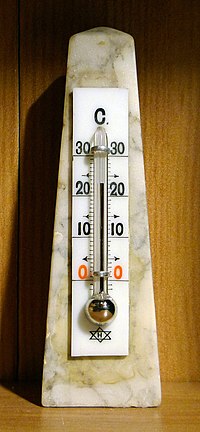
Photo from wikipedia
A numerical model was developed to determine the year-round temperature distribution within liquid manure storages, which is relevant for modelling temperature-dependent greenhouse gas and ammonia emissions. The model considers net… Click to show full abstract
A numerical model was developed to determine the year-round temperature distribution within liquid manure storages, which is relevant for modelling temperature-dependent greenhouse gas and ammonia emissions. The model considers net short and long-wave radiation, heat conduction through walls and floor, surface convective heat transfer, evaporative heat loss, and manure loading. The model was implemented and validated for a circular concrete storage tank (40 m diameter; 2.5 m depth) on a dairy farm in Ontario, Canada, where it is assumed that heat transfer occurs in horizontal and vertical directions, and is symmetric in the angular direction. Annual root mean square error (RMSE), Nash–Sutcliffe model efficiency, coefficient of determination, and average bias between model estimates and measured values were 2.4 °C, 0.91, 0.95, and 0.12 °C, respectively. The model performed best in summer and autumn (lowest RMSE), which are the most important seasons for modelling temperature, as both temperature and manure volume are highest, leading to the greatest opportunity for gaseous emissions. A sensitivity analysis indicated that the most significant parameters were solar absorptivity, manure depth, incoming manure temperature, emissivity, and wind-speed. For every unit increase in depth (m), incoming manure temperature (°C), or wind-speed (m s −1 ), the peak summer temperature changed by −7.3, 0.3, or −2.4 °C, respectively. Parameters with little effect on temperature were the manure solids content and thermal conductivity of soil around the sides and the bottom of the tank. Results show that heat transfer is primarily 1-dimensional, and a simplified 1-D model would be sufficient for future applications.
Journal Title: Biosystems Engineering
Year Published: 2017
Link to full text (if available)
Share on Social Media: Sign Up to like & get
recommendations!